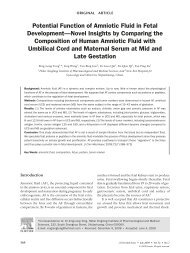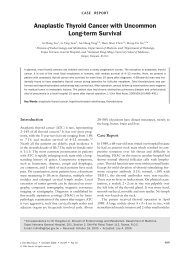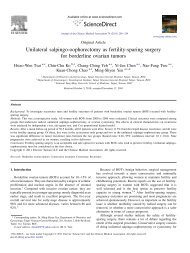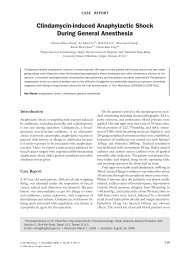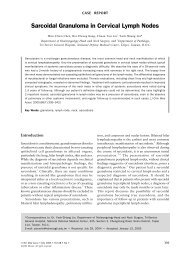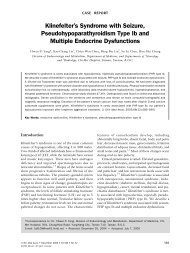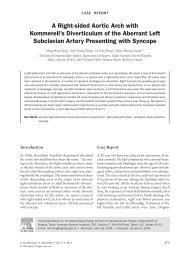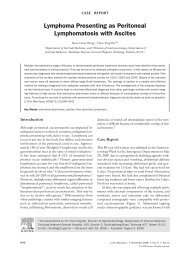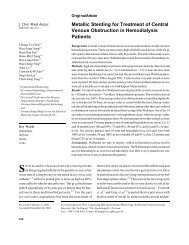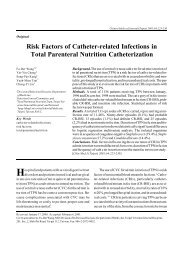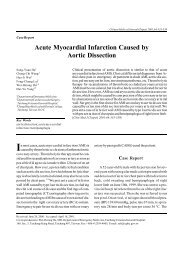Surgical Anatomy of Supratentorial Midline Lesions
Surgical Anatomy of Supratentorial Midline Lesions
Surgical Anatomy of Supratentorial Midline Lesions
Create successful ePaper yourself
Turn your PDF publications into a flip-book with our unique Google optimized e-Paper software.
Arteries <strong>of</strong> the insula<br />
divided into many smaller branches. We observed at least<br />
one large, maximum four, LLAs in each hemisphere. The<br />
origins <strong>of</strong> the LLAs varied. Seventy-eight percent originated<br />
from the M 1 segment, usually on the inferomedial<br />
aspect. In 18%, however, the LLAs originated from a<br />
frontal or temporal branch and, in 4%, the LLAs originated<br />
from the superior or inferior trunk <strong>of</strong> the M 2 segment<br />
and were located near to the main bifurcation <strong>of</strong> the MCA.<br />
There were no communications among the branches <strong>of</strong><br />
LLAs in the subarachnoid space. In 15 hemispheres<br />
(37.5%), the M 1 segment gave rise to a frontal branch<br />
(lateral orbit<strong>of</strong>rontal artery) and, in nine hemispheres<br />
(22.5%), this frontal branch gave rise to strong LLAs (Fig.<br />
2 lower). In the remaining six hemispheres (15%), the<br />
LLAs arose directly from the M 1 segment, in proximity to<br />
the origin <strong>of</strong> the frontal branch. Following their branching<br />
from the M 1 segment, the LLAs turned abruptly, forming<br />
an acute angle at their origins, and coursed medially 4 to<br />
5 mm, before turning superiorly to enter the lateral portion<br />
<strong>of</strong> the anterior perforated substance. Viewed laterally, the<br />
LLAs revealed a fanlike pattern, beginning at the base <strong>of</strong><br />
the brain and radiating to extend over almost the entire internal<br />
capsule (Fig. 4).<br />
In 22 hemispheres (55%), the small branches <strong>of</strong> the M 1<br />
segment were observed to contribute to the vascularization<br />
<strong>of</strong> the insula. Between one and six arteries arose from<br />
the distal M 1 segment and supplied the region <strong>of</strong> the limen<br />
insulae. In 25 hemispheres (62.5%), the lateral orbit<strong>of</strong>rontal<br />
artery arose from the M 1 segment, extending branches<br />
to supply the transverse and accessory insular gyri; this<br />
artery became the M 3 segment and the M 2 segment was<br />
absent. Similarly, when the temporal polar and anterior<br />
temporal arteries arose from the temporal branch <strong>of</strong> the<br />
M 1 segment on its lateral aspect, the M 2 segment <strong>of</strong> these<br />
arteries was also absent and no branches supplied the<br />
insula.<br />
Insular (M2) Segment <strong>of</strong> the MCA<br />
The MCA was observed to divide into superior and inferior<br />
trunks, usually at the level <strong>of</strong> the limen insulae, and<br />
the trunks coursed over the insular cortex as the M2 segment.<br />
In 35% <strong>of</strong> hemispheres, the superior trunk was larger<br />
than the inferior trunk; in an additional 15% <strong>of</strong> hemispheres<br />
they were equal; and in the remaining 50% <strong>of</strong><br />
hemispheres, the inferior trunk was larger. The average diameter<br />
<strong>of</strong> the superior trunk <strong>of</strong> the M2 segment was 2.51<br />
mm (range 1.6–3 mm) and the average diameter <strong>of</strong> the inferior<br />
trunk <strong>of</strong> the M2 segment was 2.35 mm (range 1.3–3<br />
mm). The angle between the superior and inferior trunks<br />
<strong>of</strong> the M2 segment was found to vary; the average was 91º<br />
(range 35–160º). In three hemispheres (7.5%), either the<br />
superior or inferior trunk <strong>of</strong> the M2 segment gave rise to<br />
one or two small LLAs, immediately after the bifurcation.<br />
In 22 hemispheres (55%) either the superior or inferior<br />
trunk <strong>of</strong> the M2 segment (whichever trunk was more dominant)<br />
bifurcated again distal to the main bifurcation, giving<br />
rise to an “intermediate trunk.” In 18 hemispheres<br />
(45%), this intermediate trunk arose from the superior<br />
trunk and, in the remaining four hemispheres (10%), it<br />
arose from the inferior trunk. In five hemispheres<br />
(12.5%), this second bifurcation (intermediate trunk) occurred<br />
close to the main bifurcation, giving the impression<br />
J. Neurosurg. / Volume 92 / April, 2000<br />
<strong>of</strong> a trifurcation. In an additional hemisphere (2.5%), both<br />
the superior and inferior trunks bifurcated immediately after<br />
the main bifurcation, resembling a quadrifurcation.<br />
At the region <strong>of</strong> the limen insulae, not always are just<br />
the superior and inferior trunks <strong>of</strong> the MCA encountered;<br />
sometimes three to five truncal arteries are encountered<br />
as well. Along the superior and inferior periinsular sulci,<br />
the M 2 segment had an average <strong>of</strong> 9.6 branches (range<br />
eight–12 branches), before becoming M 3 segment. These<br />
branches arose mainly from the superior trunk and<br />
branched further over the anterior insula.<br />
In each hemisphere, the prefrontal artery was located in<br />
the region <strong>of</strong> the anterior insular point (Figs. 1, 4 upper,<br />
and 5). The prefrontal, precentral, and central arteries,<br />
and, in 22.5% <strong>of</strong> the hemispheres, the anterior and posterior<br />
parietal arteries fanned out over the insula from the superior<br />
trunk. They predominantly supplied the anterior<br />
portion <strong>of</strong> the insula. On reaching the superior periinsular<br />
sulcus these branches angled sharply to become the<br />
M 3 segment, the so-called “candelabra arteries.” In each<br />
hemisphere the central artery, or the trunk that included<br />
the central artery, traveled either partially or totally along<br />
the central sulcus <strong>of</strong> the insula (Figs. 1, 4 upper, and 6). It<br />
was never observed to originate from the frontal or temporal<br />
branches that arose from the M 1 segment. The central<br />
insular sulcus is the most vascularized portion <strong>of</strong> the<br />
insula. At the region <strong>of</strong> the posterior insular point, one or<br />
two arteries were observed to course to the postinsular sulcus<br />
to become the M 3 segment and, later to divide to become<br />
the M 4 segment on the surface <strong>of</strong> the cerebral cortex<br />
at the posterior aspect <strong>of</strong> the sylvian fissure. These arterial<br />
branches represent the continuation <strong>of</strong> the MCA along<br />
the sylvian fissure and, subsequently, over the posterior<br />
portion <strong>of</strong> the insula, providing multiple insular arteries.<br />
The posterior parietal artery was always observed to arise<br />
from these branches (Figs. 1 and 4 upper). The central artery<br />
was observed to arise from these branches in three<br />
hemispheres and from the anterior parietal, posterior parietal,<br />
angular, and temporooccipital arteries in four additional<br />
hemispheres. The posterior and middle temporal arteries<br />
arose from the inferior trunk <strong>of</strong> the M 2 segment and<br />
coursed along the region <strong>of</strong> the inferior periinsular sulcus<br />
to become the M 3 segment. The temporal branch, which<br />
arises from M 1, always courses laterally to other M 2 segments,<br />
which are located over the surface <strong>of</strong> the insula.<br />
Opercular (M3) Segment <strong>of</strong> the MCA<br />
The course <strong>of</strong> the M3 segment’s complex <strong>of</strong> arteries<br />
commences in the anterior, superior, and inferior periinsular<br />
sulci, continues along the hidden medial surface <strong>of</strong> the<br />
opercula, and becomes the course <strong>of</strong> the M4 segments on<br />
the surface <strong>of</strong> the sylvian fissure (Fig. 5). The M3 segments<br />
pass over the insula parallel to the M2 segment, but<br />
extend in opposite directions. The M3 segments supplied<br />
the medial surface <strong>of</strong> the opercula; however, in 10 hemispheres<br />
(25%), they also gave rise to one or two small insular<br />
arteries, which supplied the region <strong>of</strong> either the superior<br />
or inferior periinsular sulcus. The lateral orbit<strong>of</strong>rontal<br />
and temporal polar arteries demonstrated a particular characteristic:<br />
when these arteries arose from the M1 segment,<br />
they immediately became the M3 segments, giving no<br />
branches to the insula.<br />
679



